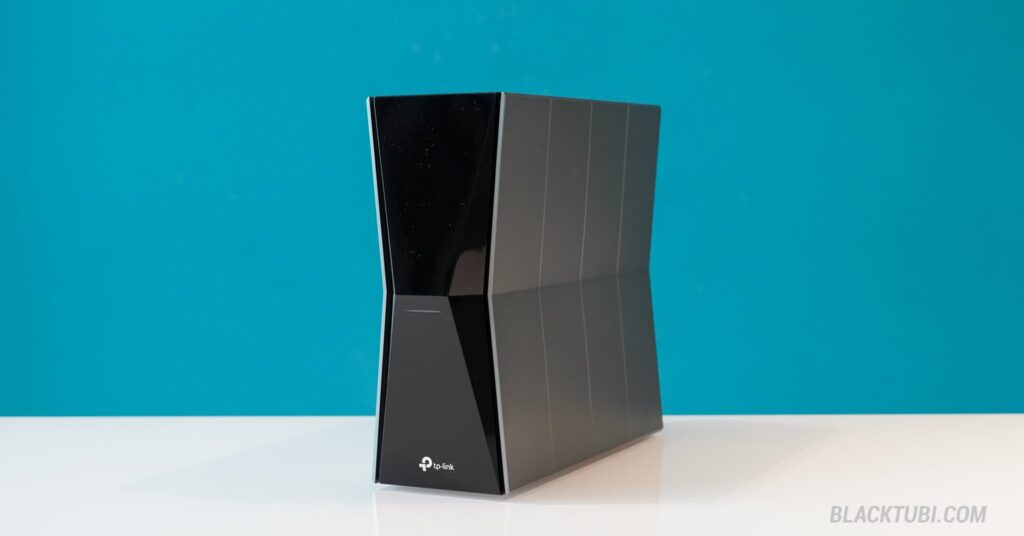
The uptake of Wi-Fi 7 is accelerating, as evidenced by the support for this advanced wireless standard in almost all flagship mobile devices released in 2024. TP-Link’s latest offering, the Archer BE805, is a flagship tri-band Wi-Fi 7 wireless router that supports speeds up to Wi-Fi 7 BE19000, and includes support for the ultra-high-performance 6GHz band.
Investing in a Wi-Fi 7 router today can future-proof your network, preventing it from becoming obsolete in the coming years. That’s because Wi-Fi 7 provides substantially faster performance on the 6GHz band, along with introducing new technologies like Multi-Link Operation (MLO) to enhance network stability. It’s also perfectly backwards compatible with older Wi-Fi 6 or even Wi-Fi 5 devices.
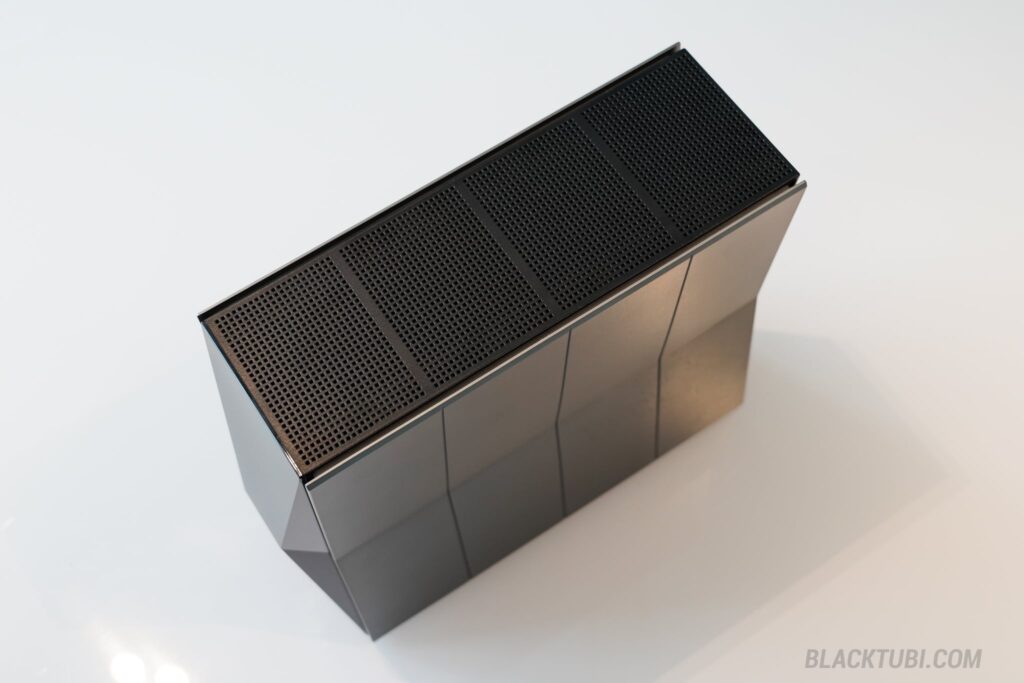
TP-Link Archer BE805 is an excellent choice with flagship specifications and full Wi-Fi 7 capabilities right out of the box. It’s also a doppelganger of the Archer BE800 that I reviewed previously with some specifications optimized which make it a more affordable product. In fact, it might be more suitable for a vast majority of users looking for a flagship level performance without breaking the bank.
The build quality of the Archer BE805 is really good with solid plastic and a sleek metallic-esque finishing on the surface. However, I’m not really a fan of the glossy black plastic at the front which shows fingerprint easily. It’s also a really huge router with a similar size compared to the Archer BE800. It’s almost as big as a gaming console and certainly one of the biggest wireless router in the market.
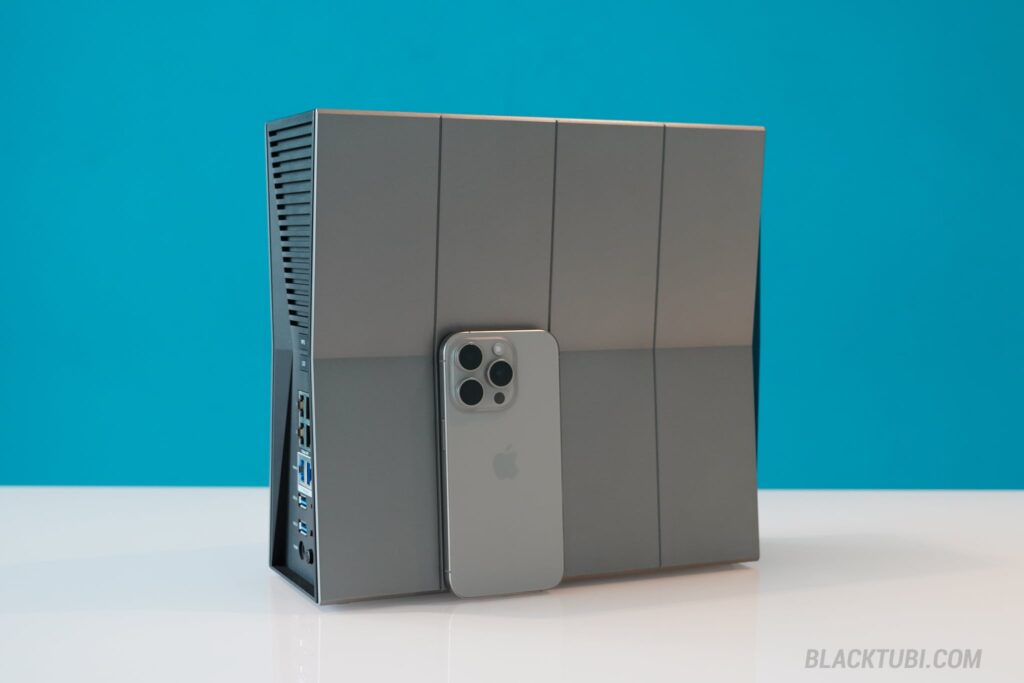
I actually prefer the stand-up design of the Archer BE805 compared to conventional wireless routers with physical antennas. That’s because the footprint of the router is smaller on my TV cabinet and it means the router is slightly higher which is better for signal penetration. Speaking of signal, the Archer BE805 comes with 10 individual antennas cleverly encased inside the chassis for a really strong Wi-Fi signal.
Archer BE805 Specifications
| 2.4GHz Wi-Fi | 4×4 BE 1376Mbps up to 40MHz |
| 5GHz Wi-Fi | 4×4 BE 5760Mbps up to 160MHz |
| 6GHz Wi-Fi | 4×4 BE 11520Mbps up to 320MHz |
| Chipset | Mediatek Filogic 880 1.8GHz Quad-Core |
| Ports | 1x 10G WAN + 1x 10G LAN + 4x Gigabit LAN + 2x USB 3.0 |
The Archer BE805 is powered by Mediatek Filogic 880 which includes a Quad-Core 1.8GHz CPU and 1GB RAM. Although the CPU clock speed is slower than the Archer BE800, it’s not really noticeable in reality as the Archer BE805 uses a dedicated Network Processing Unit (NPU) to accelerate network performance. On the bright side, the Archer BE805 runs at a much lower temperature and do not require fans.
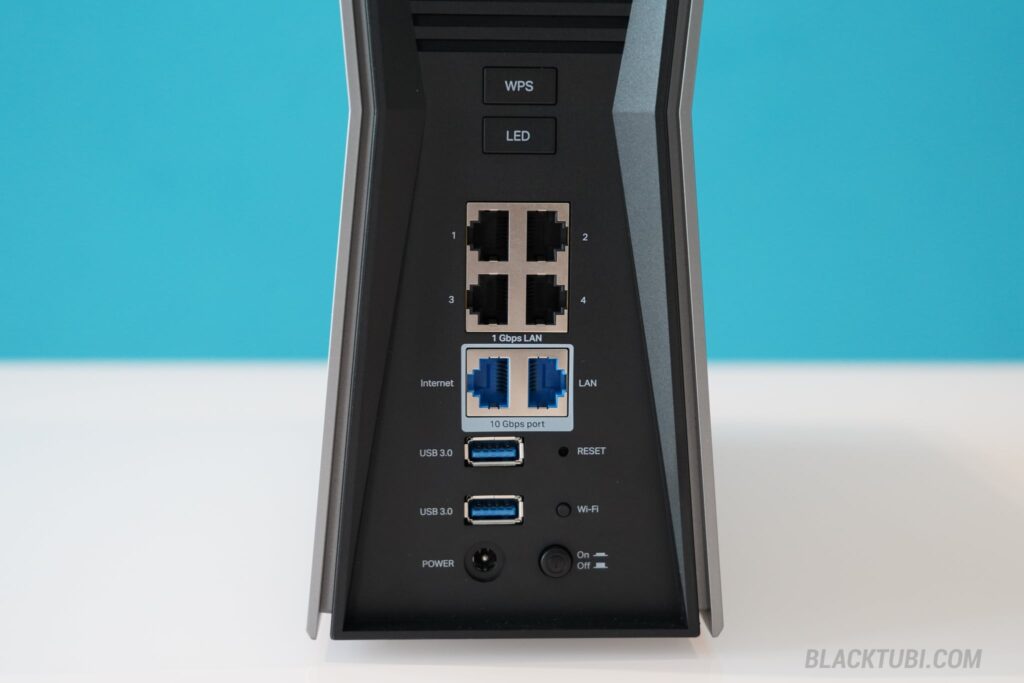
For those planning to get a 10Gbps Internet eventually in the future, the Archer BE805 will be a great choice since it’s equippped with dual 10G Ethernet LAN/WAN port. All the remaining 4 LAN ports can support up to Gigabit Ethernet LAN. That’s a small downgrade over the 4x 2.5G LAN on Archer BE800.
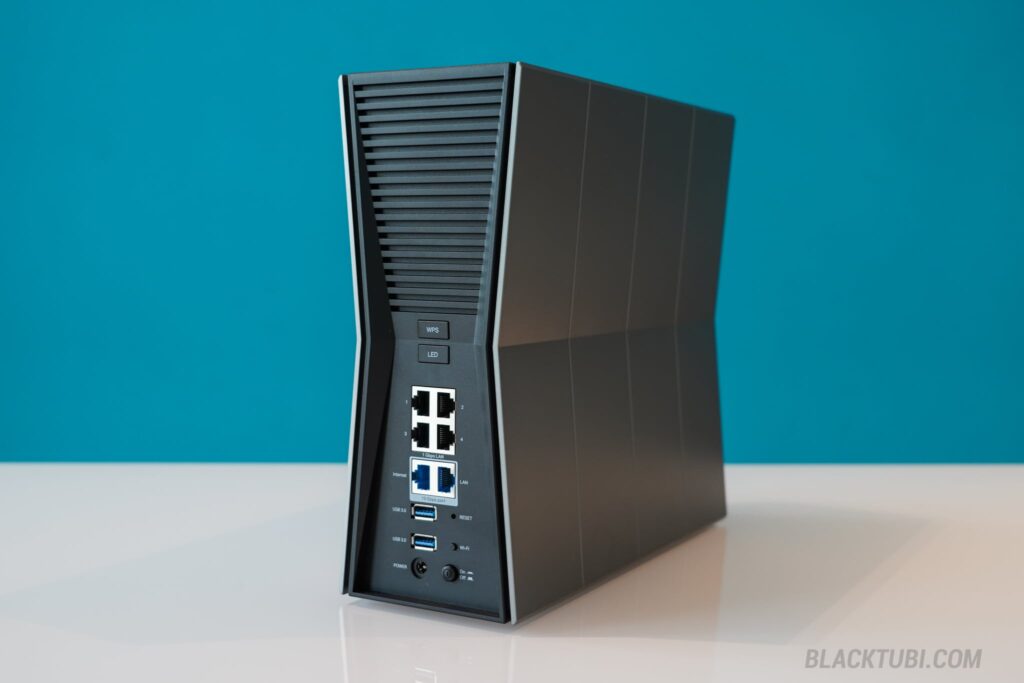
The Archer BE805 comes with 2 high-speed USB 3.0 ports which is slightly more when compared to the Archer BE800. The USB ports can support file sharing over the network when a USB storage device is connected, turning the router into a rather fast basic NAS storage device.
Archer BE805 : Class-Leading Wi-Fi 7 Performance
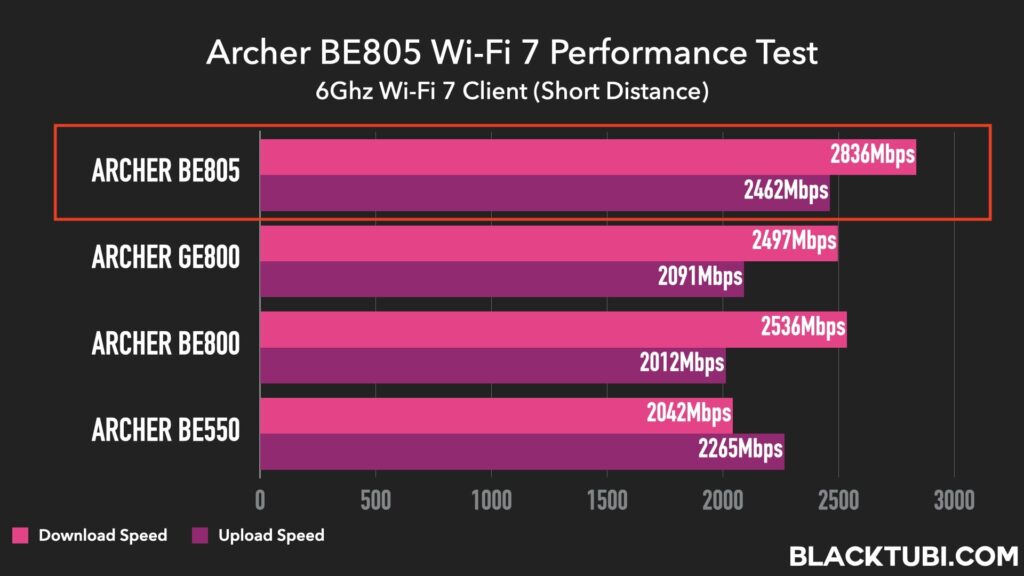
The Wi-Fi 7 performance on the Archer BE805 is probably the fastest within all TP-Link Wi-Fi 7 routers that I’ve tested, even slightly beating the Archer GE800 gaming router. Mediatek has done a really great job on their Wi-Fi 7 radios, providing a really excellent performance across all bands even on older Wi-Fi devices.
At a distance of around 5 meters, I manage to obtain an average download speed of 2836Mbps on my laptop with the Intel BE200 Wi-Fi 7 wireless adapter. This is already faster than a 2.5G wired LAN connection and it can be even faster when Intel and Microsoft finally enabled the MLO network function for Windows 11 in the future.
With this level of performance, it’s perfect for those who require a really fast network connection. For example, I can now store files or edit video project file that’s stored on my NAS storage server at a speed that’s even faster than most wired Ethernet LAN connection. Wi-Fi 7 will also enable many new experience such as streaming content to a VR/AR headset without wires.
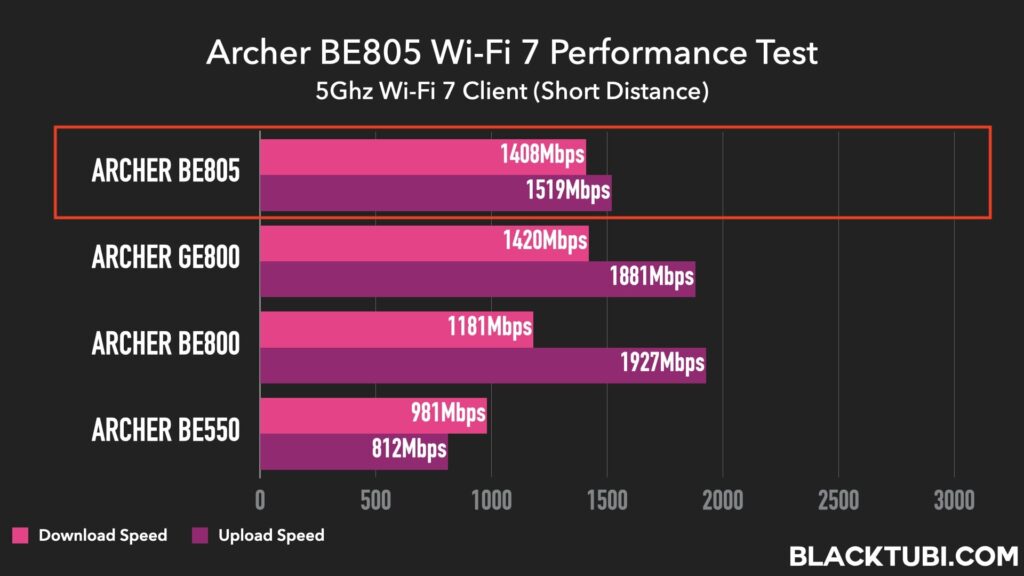
However, the range of the 6GHz network will be rather limited. That’s the unfortunate downside with high frequency network as it’s weaker at penetrating walls but it’s able to carry significantly more data. I’ll suggest changing to the 5GHz network once you’re over 2 walls from the wireless router.
The 5GHz download speed of the Archer BE805 is the fastest among all TP-Link Wi-Fi 7 routers that I’ve tried, further cementing the Archer BE805 as the true flagship model within TP-Link’s range of Wi-Fi 7 products. However, it seems like the upload speed of the Archer BE805 is slightly slower when compared to the other three models within TP-Link’s flagship Wi-Fi 7 lineup.
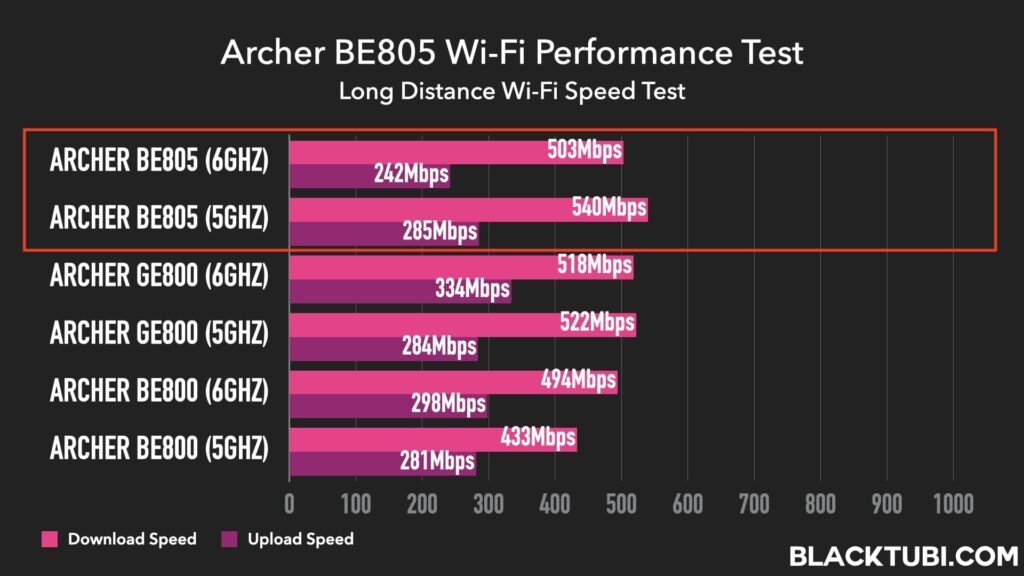
The lead in performance continue in the long distance Wi-Fi performance comparison. The 5GHz Wi-Fi download speed of the Archer BE805 is the fastest when several walls are involved, even surpassing the both the Archer BE800 and Archer GE800 that are more expensive than the Archer BE805. However, I notice a very similar trend where the upload performance on the Archer BE805 is slightly slower.
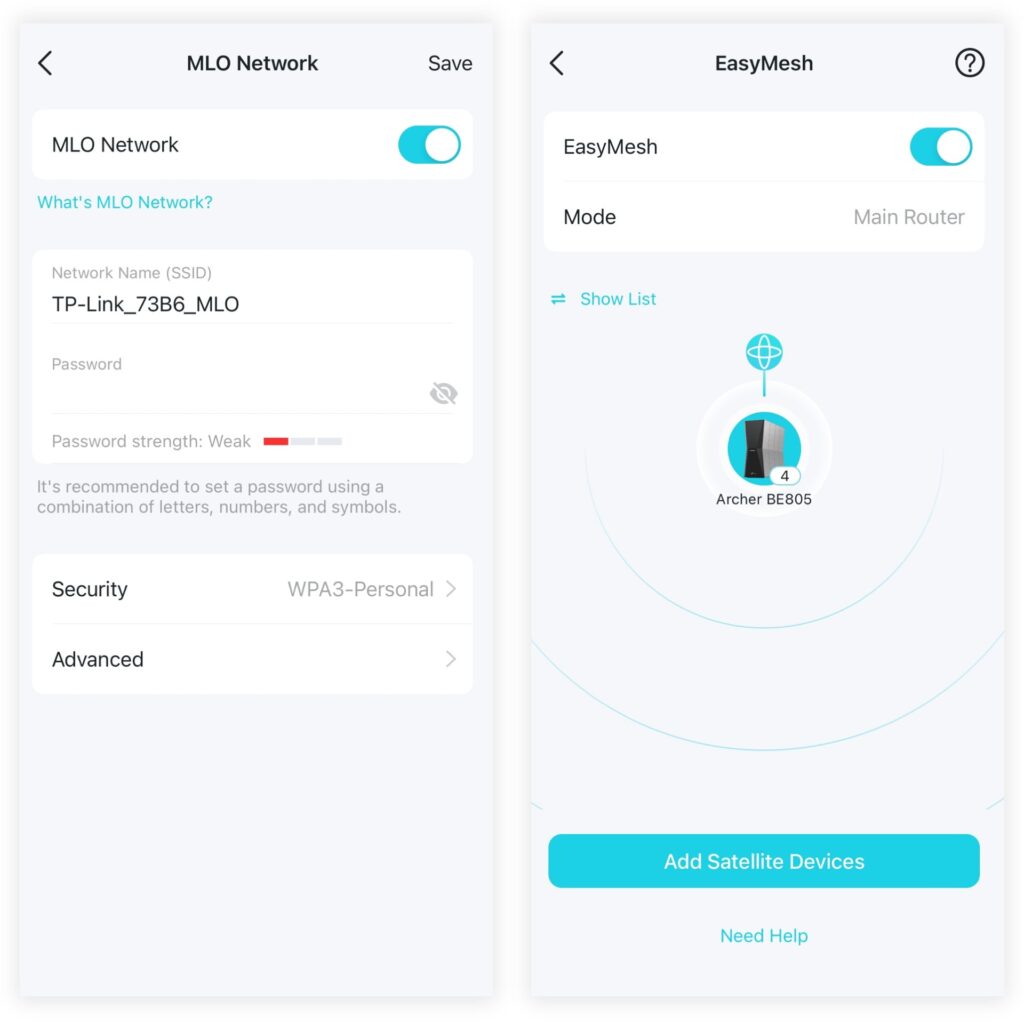
The Archer BE805 supports Wi-Fi 7 Multi-Link Operation (MLO) feature right out of the box. The MLO feature will allow a supported device to simultaneously connects to all 3 Wi-Fi bands, improving bandwidth and stability. It will minimize the impact caused by band steering as the device can switch between the bands more seamlessly without having to reinitiate a new connection.
Firmware and Features
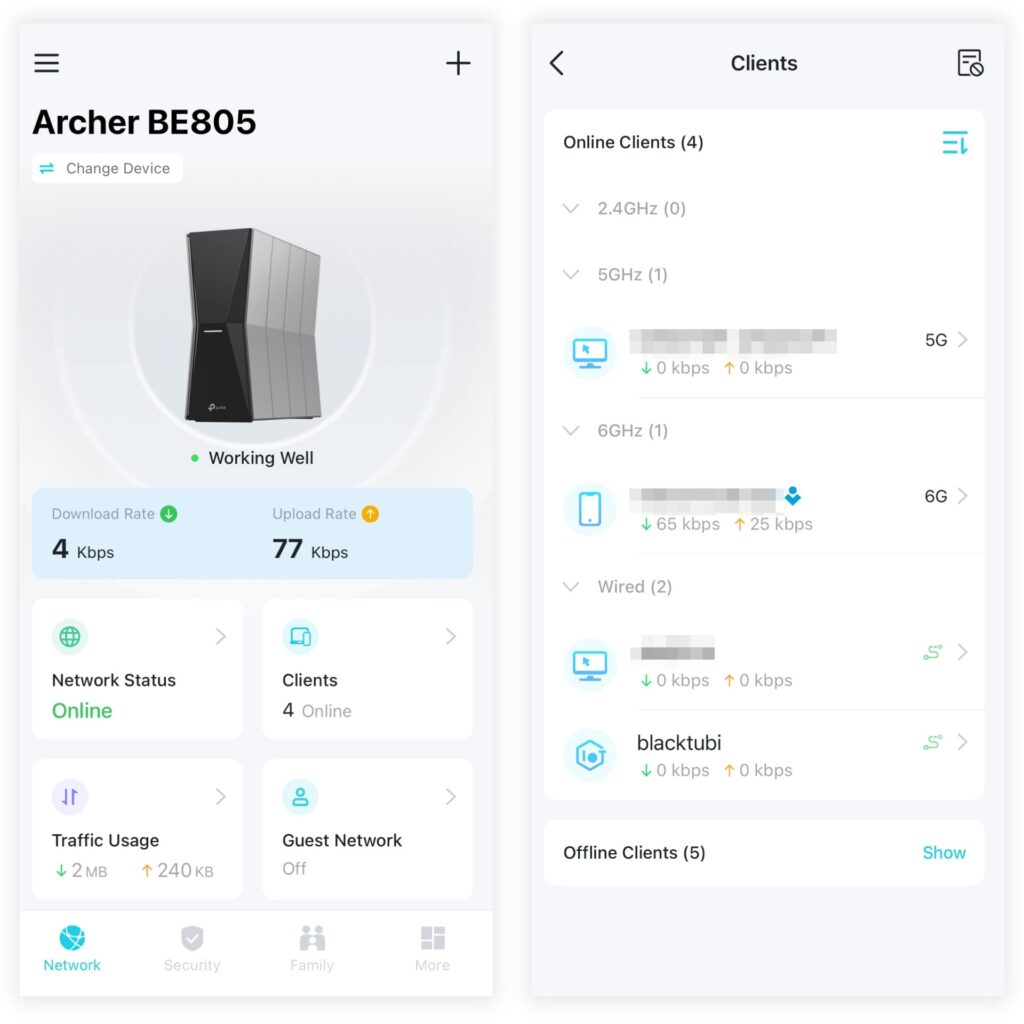
The firmware experience are very similar across all TP-Link Wi-Fi 7 models. They all offer a similar set of features with great performance and stability. TP-Link did an excellent job at modernizing the firmware with a user-friendly interface on the TP-Link Tether app. The app can show things like the list of connected devices, configure device blocking and speed limitation easily.
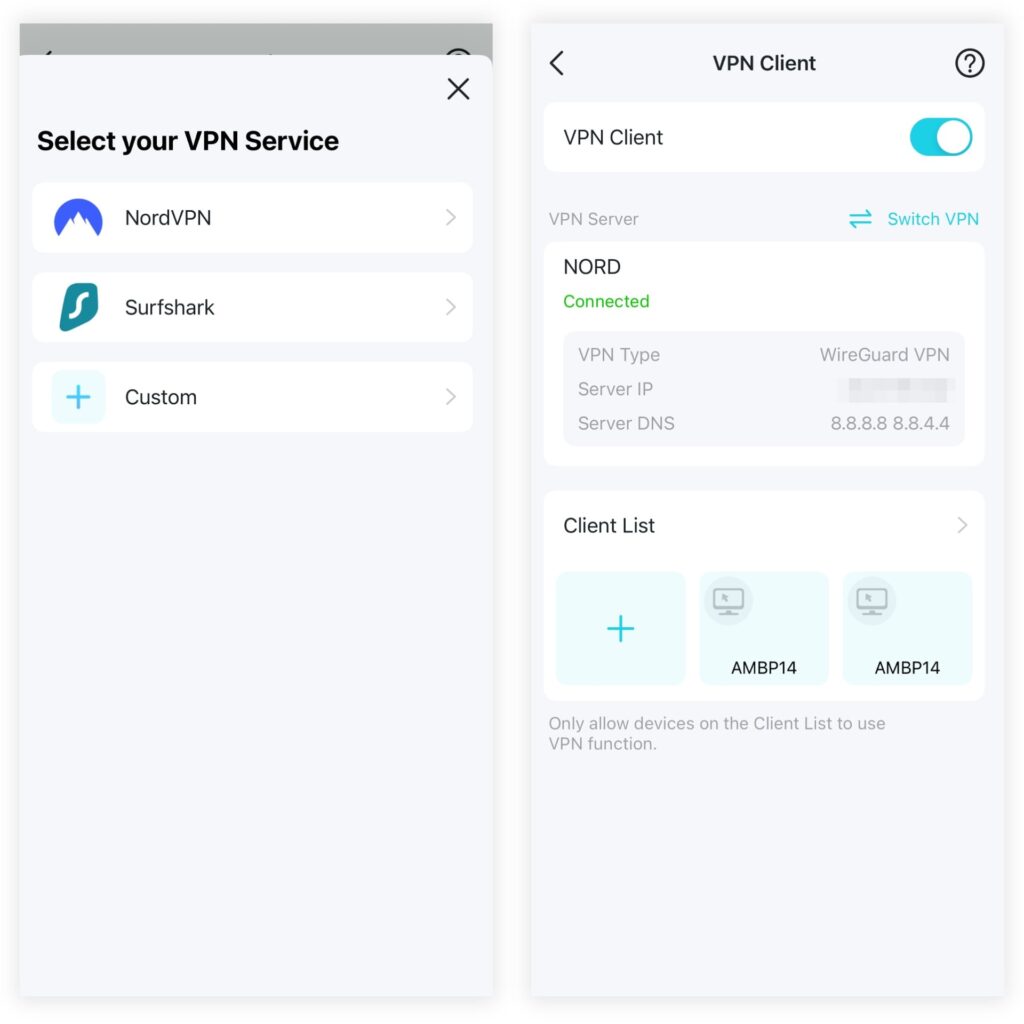
TP-Link greatly enhanced the VPN capability on their Wi-Fi 7 routers. It’s able to support a Wireguard based VPN connection in addition to the usual OpenVPN or IPSec VPN server. With that, the VPN performance is much faster, reaching over 850Mbps on a Wireguard server. I can even select the devices that will be routed through the VPN easily on the TP-Link Tether app as well.
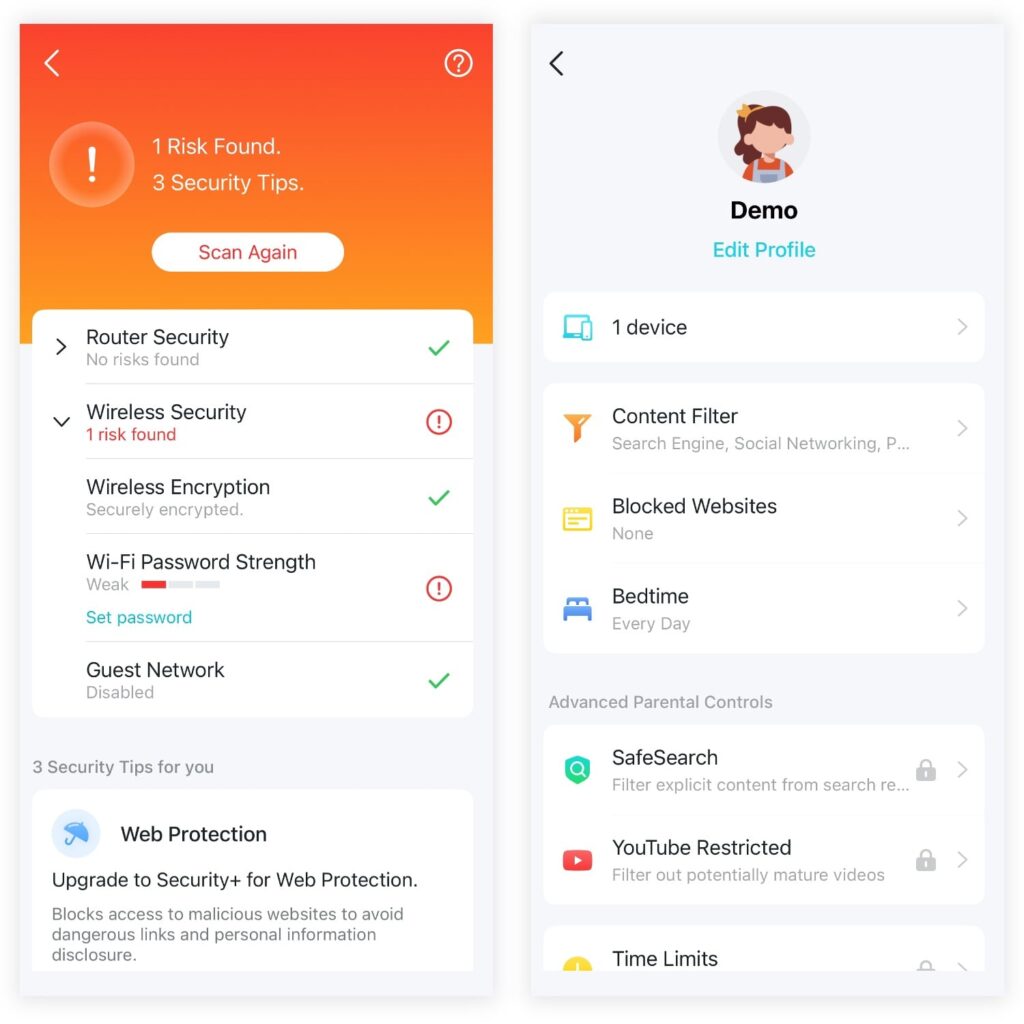
TP-Link excellent HomeShield parental control and security suite is available here. It can block scam or malware infected webpages from being access by devices connected to the wireless router. As for the parental control, it can block access to certain categories of websites for selected devices. It’s also possible to configure Internet access schedule without additional charge with HomeShield.
The subscription-only HomeShield Pro package comes with the more advanced parental control feature on the Tether app. It can provide more information on the network usage for selected devices by showing usage time history, frequently browsed webpages and more. It will also provide a more granular control of Internet usage time limitation such as usage quota and app filtering funtion.
Closing Thoughts
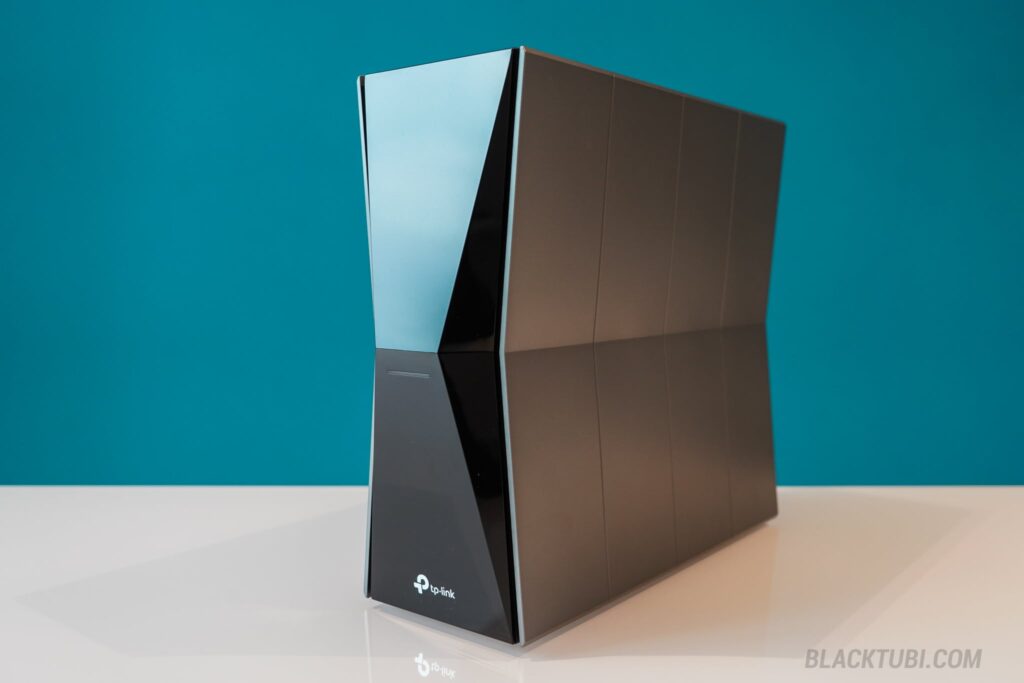
The Archer BE805 is probably the best choice in TP-Link’s flagship Wi-Fi 7 lineup and it’s not hard to see why. It’s cheaper than the Archer BE800 with a faster Wi-Fi. It also produces less heat and operates at a lower temperature. While it doesn’t come with 4x 2.5G LAN ports, it’s irrelevant for many users including myself. For me, the Archer BE8005 is a better value proposition and as an overall package.
The user-experience of the Archer BE805 is consistent with other premium TP-Link flagship Wi-Fi 7 routers. It has a really good software and a well designed Tether app. While some features like the advanced parental control will require a subscription, the firmware of the Archer BE805 is really stable and reliable, something I appreciate on a premium wireless router.
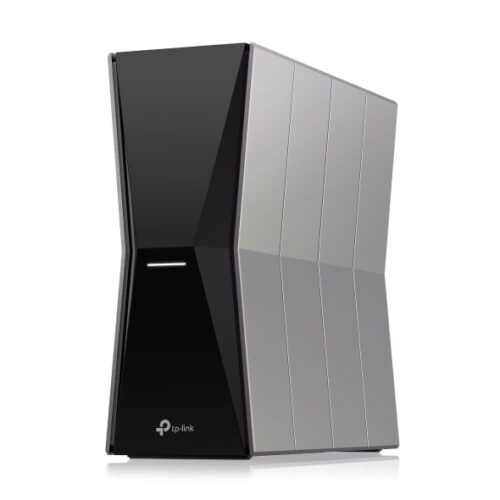
TP-Link Archer BE805
9.3
Tubi Rating
pros
- Robust and reliable Wi-Fi and CPU performance with minimal heat
- Easy network expansion with EasyMesh function
- Sleek and modern design without visible antennas
cons
- Monthly subscription required to get more features from HomeShield Pro
- Comes with 4x Gigabit LAN ports instead of 4x 2.5G LAN ports

Hello Blacktubi, I really enjoy reading your informative reviews! Thank you for your efforts really appreciate it. I have a question. I’m building a 3-storey, 8300 sqft house, with each floor around 2100 sqft. I can’t decide whether to get a GE800 as a main router with 2 BE805s on each floor as access points, or just 3 Deco BE85 units. Both setups will be connected via LAN, with 3 LAN points on each floor. I’m on a Unifi 1GB plan, and the price difference between the two options is minimal—the GE800 option being slightly cheaper. I chose the GE800… Read more »
I actually prefer the Deco BE85 for a simple reason – seamless roaming. The roaming is so much better on their Deco lineup as they are designed to be a mesh product from the groundup. While TP-Link claims it’s AI-roaming, it’s probably more of a very sophisticated algorithm and it works extremely well. It even support 802.11r fast roaming for almost gapless transition which many competitors don’t. I don’t think you can bypass the modem with the SFP+ ONU module, at least there’s no stable solution so far. Just stick to the telco provided modem router. If you got the… Read more »
Hi Blacktubi, Thank you very much for your time and for your insightful advice. I truly appreciate it. I’ve decided to follow your recommendation and go with the Deco BE85 setup. Regarding the connection setup, since bypassing the modem with the SFP+ ONU module isn’t possible, I will use the unifi provided modem. However, I have a follow up question. Can I use an RJ45 SFP+ module to connect to the BE85? Specifically, I am considering the following setup: Modem (in bridge mode) > LAN > RJ45 SFP+ module > BE85 SFP+ port. Could this method work? So I can… Read more »
Nope this method wouldn’t work. If you used the SFP+ port, 1 of the Ethernet port will be disabled on the BE85.
Can you please test the speed with MLO?
Unable to test as MLO is still not supported on Windows 11.
Does this router support wireless mesh on 6Ghz backhaul?
It should use the 6GHz band as the backhaul when being configured with another 6GHz capable. However, since EasyMesh is pretty much an open thing, it’s hard to be sure if another router will handle it this way.
I just wanted to ask how is the wifi coverage compared to Tp-Link AX73 ? Is it same or 15-20% better?
It’s slightly better than Archer AX73, probably 5-10% better. The main difference would be the speed and stability.